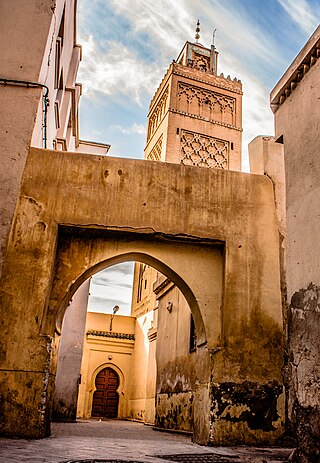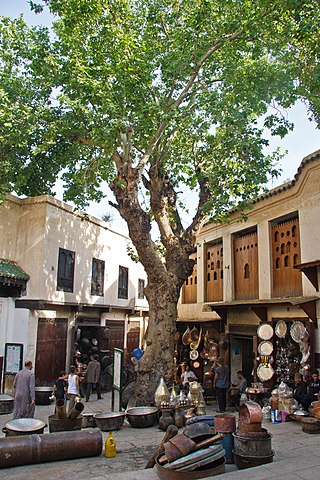
A mellah is the place of residence historically assigned to Jewish communities in Morocco.

Moulay Idriss, Moulay Driss Zerhoun or simply Zerhoun is a town in the Fès-Meknès region of northern Morocco, spread over two hills at the base of Mount Zerhoun. It is famous for being the site of the tomb of Idris I, the first major Islamic ruler of Morocco, after whom the town is named. It is located near Meknes and overlooks the ruins of Volubilis a few kilometers away.

Fes el Bali is the oldest walled part of Fez, the second largest city of Morocco. Fes el Bali was founded as the capital of the Idrisid dynasty between 789 and 808 AD. UNESCO listed Fes el Bali, along with Fes Jdid, as a World Heritage Site in 1981 under the name Medina of Fez. The World Heritage Site includes Fes el Bali's urban fabric and walls as well as a buffer zone outside of the walls that is intended to preserve the visual integrity of the location. Fes el Bali is, along with Fes Jdid and the French-created Ville Nouvelle or “New Town”, one of the three main districts in Fez.

Fes Jdid or Fes el-Jdid is one of the three parts of Fez, the second largest city of Morocco. It was founded by the Marinids in 1276 as an extension of Fes el Bali and as a royal citadel and capital. It is occupied in large part by the historic Royal Palace, which was once the center of government in Morocco and which is still used on occasion by the King of Morocco today. The district also contains the historic Mellah of the city. Since 1981 it has been classified, along with Fes el-Bali, as a UNESCO World Heritage Site.

The Bou Inania Madrasa or Bu 'Inaniya Madrasa is a madrasa in Fes, Morocco, built in 1350–55 CE by Abu Inan Faris. It is the only madrasa in Morocco which also functioned as a congregational mosque. It is widely acknowledged as a high point of Marinid architecture and of historic Moroccan architecture generally.

Dar al-Magana is a 14th-century building in Fes, Morocco, built by the Marinid Sultan Abu Inan Faris which houses a weight-powered water clock. It is located opposite the Bou Inania Madrasa on Tala'a Kebira street and was created to serve that madrasa and its mosque, which was also built by Abu Inan around the same time.

The Al-Attarine Madrasa or Medersa al-Attarine is a madrasa in Fes, Morocco, near the Al-Qarawiyyin Mosque. It was built by the Marinid sultan Uthman II Abu Said in 1323-5. The madrasa takes its name from the Souk al-Attarine, the spice and perfume market. It is considered one of the highest achievements of Marinid architecture due to its rich and harmonious decoration and its efficient use of limited space.

The Marinid Tombs or Merenid Tombs are a set of ruined monumental tombs on a hill above and north of Fes al-Bali, the old city of Fez, Morocco. They were originally a royal necropolis for the Marinid dynasty which ruled over Morocco in the 13th to 15th centuries. Today, they are a popular lookout point over the historic city.

Dar Batḥa, or Qasr al-Batḥa, is a former royal palace in the city of Fez, Morocco. The palace was commissioned by the Alaouite Sultan Hassan I in the late 19th century and finished under his successor Abdelaziz. It was converted into a museum of historical arts and crafts in 1915 with a collection that now comprises over 6,500 objects. The palace is located near Bab Bou Jeloud at the western edge of Fes el-Bali, the old medina quarter of the city, and close to Fes el-Jdid, the new medina quarter. It is adjacent to the Dar el-Beida palace located to its southeast, which was originally part of the same complex.

Saffarin Madrasa is a madrasa in Fes el-Bali, the old medina quarter of Fez, Morocco. It was built in 1271 CE by the Marinid Sultan Abu Ya'qub Yusuf and was the first of many madrasas built by the Marinid dynasty during their reign. It is located just south of the 9th-century Qarawiyyin Mosque on Saffarin Square, which is named after the coppersmiths who work in the square.

Bab Oudaya, also known as Bab Lakbir or Bab al-Kabir, is the monumental gate of the Kasbah of the Udayas in Rabat, Morocco. The gate, built in the late 12th century, is located at the northwest corner of the Kasbah, uphill from the medina of Rabat. It is often cited as one of the most beautiful gates of Almohad and Moroccan architecture.

The Mosque of Abu al-Hasan is a historic neighbourhood mosque in Fes el-Bali, the old medina of Fes, Morocco. It is located on Tala'a Seghira street, near the Bou Inania Madrasa.

The El-Oued Mosque is a mosque in Fes el-Bali, the historic medina of Fes, Morocco. It was built in the late 18th or early 19th century on the site of a former 14th-century madrasa by the same name.

The Mellah of Fez is the historic Jewish quarter (Mellah) of Fez, Morocco. It is located in Fes el-Jdid, the part of Fez which contains the Royal Palace, and is believed to date from the mid-15th century. While the district is no longer home to any significant Jewish population, it still contains a number of monuments and landmarks from the Jewish community's historical heritage in the city.

The Grand Mosque of Oujda is the historic main Friday mosque of Oujda, Morocco. The mosque was founded by the Marinid sultan Abu Ya'qub Yusuf in 1296.

Place Seffarine or Seffarine Square is a small square in the medina of Fes, Morocco. It is located on the south side of the Qarawiyyin Mosque, close to the Bou Khrareb River which runs through the heart of the medina. The square dates back to the Middle Ages but has also undergone renovations in modern times. It is adjoined by the Qarawiyyin's library to the northwest, by the Saffarin Madrasa to the east, and by the Saffarin Hammam (bathhouse) to the southwest. It is named after the coppersmiths who have had their workshops here for centuries.

The Kissariat al-Kifah or Kissaria (القيسارية) is the historic central bazaar of Fes el-Bali, the historic old city of Fez, Morocco. It is located between the Zawiya of Moulay Idris II and the Qarawiyyin Mosque.

The History of Fez begins with its foundation by Idris I and Idris II at the end of the 8th century and the beginning of the 9th century CE. It initially consisted of two autonomous and competing settlements on opposing shores of what is now known as the Oued Fes. Initially inhabited by a largely Berber (Amazigh) population, successive waves of mainly Arab immigrants from Ifriqiya (Tunisia) and al-Andalus (Spain/Portugal) over time gave the nascent city an Arab character as well. After the downfall of the Idrisid dynasty, it was contested between different Zenata groups allied with either the Fatimid Caliphate or the Umayyad Caliphate of Cordoba. In the 11th century the Almoravid sultan Yusuf ibn Tashfin conquered the region and united its two settlements into what is today the Fes el-Bali quarter. Under the rule of the Almoravids and of the Almohads after them, despite losing the status of capital to Marrakesh, the city remained the economic and political center of northern Morocco and gained a reputation for religious scholarship and mercantile activity.
Judaism in Fez was a community that existed in the city of Fez in Morocco for the last thousand years. Throughout the years, there were rabbis, poets and famous linguists in this community, who greatly influenced the Jewish diaspora in Morocco and the Jewish world.

Almoravid architecture corresponds to a period from the 11th to 12th centuries when the Almoravids ruled over the western Maghreb and al-Andalus. It was an important phase in the development of a regional Moorish architecture, as the styles and craftsmanship of al-Andalus were further imported and developed in North Africa. The Almoravids founded the city of Marrakesh as their capital and built many mosques in the region, although much of what they built has not preserved. The Almoravids were overthrown by the Almohads in the 12th century, after which Almohad architecture continued to develop some of the same trends in the Maghreb and al-Andalus.





















